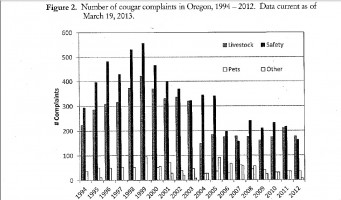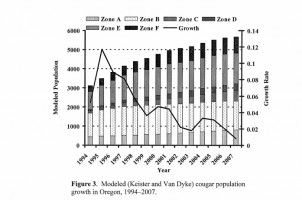By Bob Ferris
"I am personally fearful of a cougar attacking someone because they have not been managed. Their population has increased exponentially since 1994. I am also fearful that without providing the necessary tools to manage them they will continue to do what they naturally do and prey on elk and deer and that will continue to decimate our elk/deer herds and further hurt recruitment rates for elk/deer." Jerod Broadfoot on I-Fish May 15, 2013 1:11 PM
As we look at the rationale for this pending cougar bill currently under discussion in the Oregon Senate I am very much in agreement with the recent Register-Guard editorial that basically asked: What crisis?
Well…well…human safety is at risk with cougar sightings on the increase and their populations are growing exponentially. Sure we hear this often from the bill’s main proponent—Oregon Outdoor Council–but has anyone taken the time to look at the facts on these two topics?
Let’s take the handwringing about cougar sightings first. What do the state experts say on that? They basically say that after some initial increases in complaints in the 1990s that the human safety oriented complaints are basically declining. The below graph created for testimony on the cougar issues from ODFW clearly demonstrates a down ward trend (click on this graph and click on it again in other window to make larger).
What about the cougar populations that have been growing exponentially? That represents a rapidly growing threat that absolutely requires the legislature to overturn the will of the people, right? A graph, again from the ODFW, indicates that cougar populations have grown modestly over the last two decades rarely jumping into double digits and leveling out over the last few years.
So what is the real catalyst for this fear-based, full-court press on the legislature over hunting cougars with dogs? To answer that question you simply have to follow the money. Who put money into OOC and OOCF and who will add money in the future if certain actions are taken? When you look at the money trail, the answer to this becomes obvious.
"We [Oregon Outdoor Council and Oregon Outdoor Council Foundation] also have a commitment from the Oregon United Sporting Dogs Association for $5,000 more when we need additional funding to promote legislation in 2013." Memo to OHA from Jerod Broadfoot of OOC regarding campaign funding
Non-profits are certainly free to lobby—as long as they keep within the IRS limits for their organizational classification. Where we seem to have problems is when non-profits become indistinguishable from lobbying firms—which is one of the purposes for the 20% rule. With OOC/OOCF that line isn’t simply blurred, it has been jumped over with vigor.



